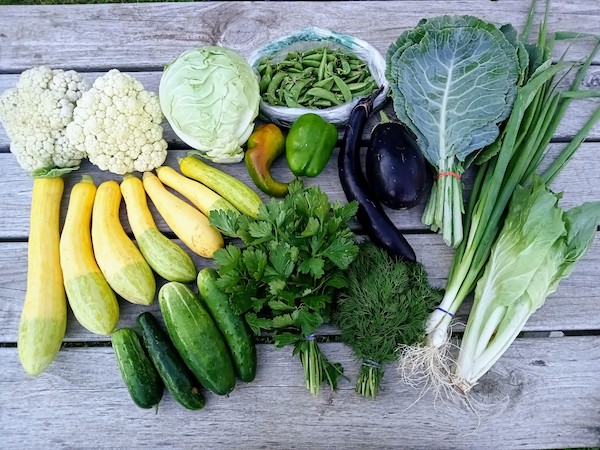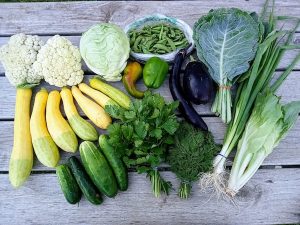
“Life’s a garden. Dig it”
~Joe Dirt~
- Summer Squash/Zucchini – All Shares
- Cucumbers – All Shares
- Cabbage – All Shares
- Cauliflower – All Shares
- Scallions – All Shares
- Peppers (Bells and/or Beaver Dam) – All Shares
- Collard Greens – All Shares
- Parsley – All Shares
- Dill – All Shares
- Green Beans or Sugar Snap Peas – Full & Half Shares
- Eggplant – Full & Flex Shares
- Radicchio – Flex Shares Only
Life on the farm is a simple yet meaningful existence. We work hard, and we relax even harder once that work is done. There is an interesting dichotomy between wanting to have access to all the crops we know and love, and having to put in the work maintaining them. Squashes and Zucchinis are a perfect example of this. A wonderfully bountiful crop that will keep on shooting out new growth as long as the existing squash and zucchini have already been harvested. So to keep that tap flowing, sometimes we have to harvest these summer squash three times a week. It is a time consuming labor of love that gives us an incredible abundance. Most of those veggies make it into your box or are eaten by us farmers. The really large ones need to be removed for reasons I pointed out already, but since they lack in flavor and wouldn’t fit in a box even if we tried, those end up going to the chickens. They are very thankful for this treat, as their coos and cackles would demonstrate. The rest of the squash harvest ends up being donated to the Rochester Food Pantry. It is important to us farmers that little as possible goes to waste, whether that means preserving and canning, donating any extra produce, or composting it to enrich our soil for future seasons. We try to use the mantra of waste not want not in all aspects of our work life, since we put so much effort into getting that plant to grow and thrive. So enjoy the bounty of this week’s box, and be good to each other. Cheers!
-Farmer Dylan
Crop of the week – Alliums
Allium, the Latin word for garlic, is a genus of bulbous flowering plants with hundreds of members. Recorded history tells us that edible alliums have been used by humans for centuries. Cuneiform tablets dating back nearly 4000 years reveal that Babylonian cooks used alliums plenty! What are known as The Yale Culinary Tablets are recipes for meats & vegetables simmered in water in covered pots with garlic, leeks and onions. These aromatics have a long track record.
Garlic: A pungent aromatic that divides its bulb into cloves, garlic can be used fresh in sauces for a spicy bite or cooked over medium heat to bring out its sweetness. Cooking garlic over high heat can leave it-and everything else in the dish-with an acrid taste. Cultivated garlic falls into two main groups, hardneck & softneck. Softneck garlic growns leaves from the bulb which can be braided to dry the garlic and has a long storage life; this is the most common supermarket garlic. Hardneck garlic grows a shoot from the bulb that hardens as it matures(thus the name). It won’t store as long as softneck varieties(6-10 months generally, though I’ve had no trouble going longer) but it has a more complex and full flavor. Garlic scapes are the fresh shoots of hardneck varieties before they mature and harden.
Garlic scapes: these pale green fresh stems are a vegetable and aromatic all in one. Scapes can be sliced and stir-fried like green beans, steamed & finished with a pat of butter & a squeeze of lemon, or used in soups & stews, dips & pesto as you would an aromatic.
Leeks: A cylindrical sheath of leaves grown up from a bulb, leeks have a milder & sweeter flavor than most alliums. Many recipes tend to use them like onions to build flavor at the start of a recipe but they are historically popular as a dish on their own, roasted, baked, poached or grilled whole. Though frequently left out of recipes, the dark green parts can also be thinly sliced and sautéed, adding a rich herbal taste(I tend to use the whole plant in most recipes-why toss a perfectly edible portion?).
Onions: these alliums really add a boom of flavor that it’s hard to imagine cooking without. When used raw they offer a pungent, spicy kick and a sweet, earthy flavor when cooked. We can even caramelize them into a silky sweet almost sauce to put on anything we fancy. In general red and white onions are sweeter while yellow onions are more pungent.
Scallions: These bunching onions have slender, cylindrical bulbs attached to tubular green tops. Scallions are milder and sweeter than onions, both green and white parts can be used raw-and they offer a great pop of color. Sautéed they offer a mellow onion flavor.
Enjoy your alliums, they are the backbone of the kitchen!
~Farmer Holly
Some Recipes To Try:
[ultimate-recipe id=”6754″ template=”default”]
[ultimate-recipe id=”8371″ template=”default”]
[ultimate-recipe id=”9480″ template=”default”]


